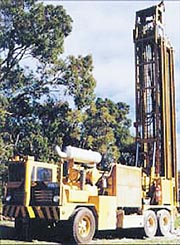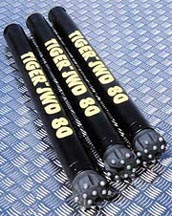
Supplier Competition
"The market is becoming more competitive," notes Lyon. "Drilling contractors have a broader choice of products now." But it's buyer beware -- especially when it comes to the hammers coming out of the Far East. Lyon's take on foreign competition: "Some of the competitors in the Asia-Pacific area, I don't see them around very much anymore and I don't hear people talking about them, so I can only presume that they're not out there any longer. With the dollar being so strong, the U.S. market is very favorable for companies that manufacture offshore; they do have the currency exchange advantage. Look at some of the hammer pricing in the foreign countries -- it's nearly a two-fold difference."
New vs. Used
When asked about the choice between buying used hammers vs. purchasing new, Lyon replies, "It depends on what type of product it is. If a driller is looking at a big foundation hammer -- a 12-inch or 20-inch hammer -- and he's not going to be using it all that often, it may well be best that he goes with a used hammer. But we continually stress the value of productivity as a way for contractors to increase their revenues, so in most cases, we'd probably promote using a new product. It's rare that you see a used tool that's in good shape."
"An exception to that," notes Young, "would be the non-lube hammers, which don't lose performance over the life of its external components. They have seals and bearings that prevent any metal-to-metal contact, so the internal components don't see the wear that the standard tools would. But these hammers are fairly finicky. It takes a very clean operation to have them run the way they're supposed to run. Drillers with experience running that type of hammer love them. But if a driller isn't as clean with his operation, he'll likely have some problems and revert back to the standard hammers. But at some point down the road, I wouldn't be surprised if the whole market went to these products due to environmental legislation that would ban putting oil into the ground."

Looking Ahead
While the hammer suppliers continually work toward improvements in speed and other innovations, they also realize that not every drilling contractor wants or needs the latest (read: most expensive) technology. "A lot of times, they are more concerned with simplicity of design and ease of service," Young notes. "Some-thing we've seen recently is some of the manufacturers going to a more simplistic hammer. The performance is the same but the customers are lured by the simplicity of the hammer components and the ease of service." That's a solid marketing strategy for the manufacturers without the research and development resources to be on the leading edge of the faster/stronger/ longer technologies."Over the years, there's consistently been a trend toward higher volume air -- not necessarily higher pressure, but higher volume," Lyon explains. "We've seen a steady progression from 825 being the norm to 900, and now you're finding in some markets, 1050, 1070 is common. In some cases, people are going all the way up to 1250.
On contractors running their drills at 400 psi, Young says, "Our compressors will operate up to those pressures, but they're really only rated to 350 psi. When people take it on their own to run the pressure up like that, they risk taking the warranty out of the picture." "But," Lyon interjects, "if a guy comes in with a broken hammer part and he says he was running it at 380 psi or something, we pretty much honor the warranty." A reasonable and common sense business practice.
Another topic broached was the trend toward smaller hammers. "We do see that happening to a certain extent -- predominantly in the blast hole market," Lyon reports. "Vibration control is an issue as urban areas spread closer to quarries, and there seems to be a move from 6-inch holes to 5-inch holes. And, of course, there are a lot more smaller holes being drilled for geothermal applications -- most of that work is 5 1¿inch holes."
Ingersoll-Rand just introduced a new line of hammers. "It's very much like our previous line," says Lyon proudly, "but it has been refined to bring more reliability and ease of service through simplicity of design, while at the same time, offering an improvement in productivity. A 6- and 3 1¿inch model came out first and we'll slowly fill out the rest of the line."
In parting, Young offers a friendly reminder to drilling contractors: "These hammer tools are much like engines and they need to be taken care of as such. Proper lubrication, proper service -- take care of them and they will take care of you."
Report Abusive Comment